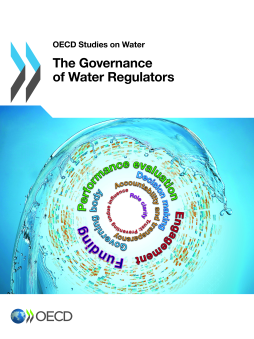
BOOK
The Governance of Water Regulators
(2015)
Additional Information
Book Details
Abstract
The establishment of dedicated regulatory bodies in charge of regulating water services, whilst being recent, is nevertheless a consistent trend among OECD and non-OECD countries. This report presents a picture as of September 2014 of the governance arrangements, operational modalities and use of regulatory tools across a sample of 34 established water regulators. It relies on the OECD Best Practice Principles for Regulatory Policy: The Governance of Regulators to structure the information collected through a survey exercise. It has been developed in close co-operation with the OECD Network of Economic Regulators (NER).
The results from the survey show that the 34 water regulators show generally a high level of adoption of good governance principles and practices. They display functions and powers that are in line with their objectives. Water regulators also show a strong culture of consultation. Other areas, in particular evaluation of regulatory impacts, could be further strengthened.
Table of Contents
| Section Title | Page | Action | Price |
|---|---|---|---|
| Cover | Cover | ||
| Table of contents | 5 | ||
| Acronyms and abbreviations | 9 | ||
| Executive summary | 11 | ||
| Chapter 1: Overview of regulatory frameworks for water services in selected countries | 13 | ||
| The challenges faced in the drinking water and wastewater service sector | 14 | ||
| An overview of regulatory functions for WWS | 15 | ||
| The variety of regulatory arrangements across countries | 16 | ||
| The development of dedicated regulatory bodies for water services | 20 | ||
| Bibliography | 24 | ||
| Chapter 2: Results of the OECD Survey on the Governance of Water Regulators | 25 | ||
| Institutional settings | 26 | ||
| The position of water regulators in the institutional landscape and co-ordination efforts with other relevant entities | 26 | ||
| The regulatory landscape | 26 | ||
| Co-ordination mechanisms | 27 | ||
| The status of the regulatory body and its founding legislation | 29 | ||
| Level of autonomy across various dimensions (political, administrative and financial) | 30 | ||
| Mandate and roles | 34 | ||
| The competencies of regulators | 34 | ||
| Role clarity | 36 | ||
| Scope of activity and market structure | 36 | ||
| Core regulatory functions and powers | 38 | ||
| Economic regulation | 40 | ||
| Monitoring of service performance | 41 | ||
| Regulatory enforcement | 42 | ||
| Customer engagement and protection | 43 | ||
| Internal organisation | 45 | ||
| Personnel | 46 | ||
| Size of regulatory bodies | 46 | ||
| The expertise embedded in the regulatory body | 47 | ||
| Terms of office | 48 | ||
| Financial resources | 50 | ||
| Operating budget of regulators | 50 | ||
| Sources of funding | 51 | ||
| Accountability mechanisms | 53 | ||
| Formal accountability | 54 | ||
| Reporting requirements on the regulator’s activities | 54 | ||
| Appeal processes | 55 | ||
| Tools and mechanisms to ensure regulatory quality | 56 | ||
| Consultation with operators and consumers | 57 | ||
| Consultation with regulated entities | 57 | ||
| Public consultation | 57 | ||
| Impact analysis of regulatory decisions | 59 | ||
| Burden reduction | 61 | ||
| Notes | 63 | ||
| Bibliography | 64 | ||
| Chapter 3: Water regulators factsheets | 65 | ||
| ALBANIA | 66 | ||
| ARMENIA | 67 | ||
| AUSTRALIA/CAPITAL TERRITORY | 68 | ||
| AUSTRALIA/NEW SOUTH WALES | 69 | ||
| AUSTRALIA/VICTORIA | 70 | ||
| AUSTRALIA/WESTERN AUSTRALIA | 71 | ||
| BELGIUM/FLANDERS | 72 | ||
| BRAZIL/RIO GRANDE DO SUL | 73 | ||
| BULGARIA | 74 | ||
| CHILE | 75 | ||
| COLOMBIA | 76 | ||
| ESTONIA | 77 | ||
| HUNGARY | 78 | ||
| INDONESIA | 79 | ||
| IRELAND | 80 | ||
| ITALY | 81 | ||
| KOSOVO | 82 | ||
| LATVIA | 83 | ||
| MALAYSIA | 84 | ||
| MOZAMBIQUE | 85 | ||
| PERU | 86 | ||
| PORTUGAL | 87 | ||
| ROMANIA | 88 | ||
| UKRAINE | 89 | ||
| UNITED KINGDOM/ENGLAND AND WALES | 90 | ||
| UNITED KINGDOM/NORTHERN IRELAND | 91 | ||
| UNITED KINGDOM/SCOTLAND | 92 | ||
| UNITED STATES/HAWAII | 93 | ||
| UNITED STATES/MAINE | 94 | ||
| UNITED STATES/OHIO | 95 | ||
| UNITED STATES/PENNSYLVANIA | 96 | ||
| UNITED STATES/TENNESSEE | 97 | ||
| UNITED STATES/WEST VIRGINIA | 98 | ||
| URUGUAY | 99 | ||
| Annex A: Participants in the OECD Survey on the Governance of Water Regulators | 101 | ||
| Annex B: Water tariff setting methodologies in selected territories | 103 | ||
| Annex C: Selected examples of water performance indicators | 107 | ||
| Drinking Water Services indicators | 110 | ||
| Wastewater Services indicators | 110 | ||
| Glossary | 113 |
